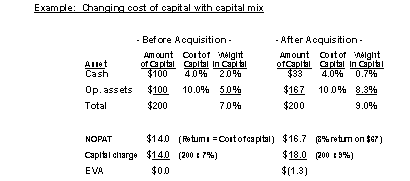Option 1: Include All Cash and Cash Equivalent Balances
For corporate entities and business units with cash balances and control over those balances, this treatment will encourage minimum cash holdings consistent with operations of the business. Management will have the incentive to actively manage cash balances and to ensure that all managers are aware of the cost of holding cash for an extended period of time.
The primary drawback of this treatment is that it may encourage conflict between operations, who want minimum cash at all times, and treasury, which must make regular determinations as to what is necessary to maintain adequate financial flexibility. Since that determination is necessarily subjective, tension may arise between the treasury, planning and capital budgeting, and operating functions. Under extreme circumstances, operations may lose faith in, and feel "hostage" to, corporate cash management decisions to the point where they are demoralized from attending conscientiously to their role in cash management, like collections.
Cost of Capital Effects
Theoretically, a capital base with a relatively high proportion of cash would be expected to have a lower cost of capital than an otherwise similar collection of assets that included little or no cash. Therefore, if a business with historically abundant cash suddenly invests most of it, the cost of capital on the remaining assets should rise. This point is relevant for a company adopting this treatment for cash if they have large and potentially fluctuating levels of cash. As noted before, it is impractical to change your cost of capital with every change in your cash position.
However, if your company experiences a significant, non-recurring shift in its cash position due to an acquisition or divestiture, or due to a change in cash management policy, then you should adjust the cost of capital accordingly. If the cost of capital is left unadjusted, managers may get rewarded for destroying value or penalized for creating value. For example, lets say that a company that has maintained a lot of cash for a few years and is about to spend most of it on new operating assets. Up to now, the company has been earning some level of EP that includes the cash and interest income. If the return on cash has been four percent and the remaining operating assets require a ten percent return, then the cost of capital for the company would be somewhere in between, depending on the proportion of cash and operating assets (see example below).

When the company buys new operating assets, the cost of capital should adapt to the new asset mix. In the example above, the companys asset mix shifts significantly toward operating assets and cost of capital should go from 7 percent to 9 percent post-expenditure. Now, lets suppose that those new operating assets provide an 8 percent return. NOPAT from the new assets would be twice the interest income the company loses from exchanging the cash for the new assets (based on an 8 percent versus a 4 percent return). If the weighted average cost of capital were left unchanged at 7 percent, EVA would be bound to go up. The company would be getting higher NOPAT with the same amount of capital and the same cost of capital.
But no value has been created by this acquisition. In fact, management would appear to be rewarded with a higher EVA for destroying value. If the cost of capital were adjusted to 9 percent to account for the dramatically lower mix of cash to operating assets, then the 8 percent return provided by the new operating assets would not be enough. EVA would drop to reveal the acquisition for the poor investment that it was.